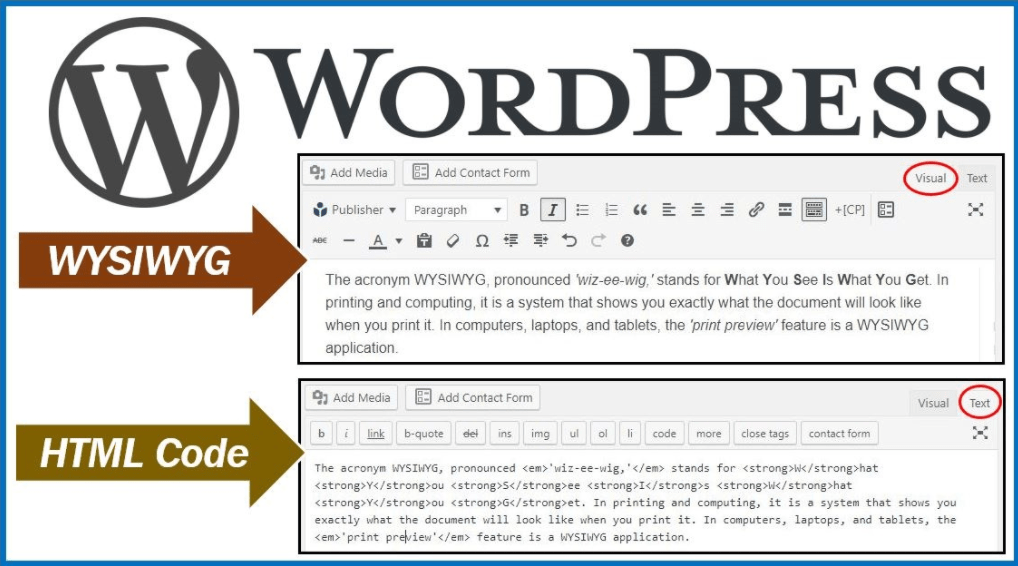WYSIWYG – What You See Is What You Get
The WYSIWYG (pronounced “wiz-ee-wig”) editor or program allows the developer to see what the end result will be when creating an interface or document. WYSIWYG is an acronym for “What You See Is What You Get“. The WYSIWYG editor is comparable to more traditional editors, requiring the developer to enter detailed code (or markup) and not allowing an instant way to view markup results. The first real WYSIWYG editor was a word processing program called Bravo. Charles Simoni was discovered at the Xerox Palo Alto Research Center in the 1970s, which became the basis for Simony’s work at Microsoft and evolved into two other WYSIWYG applications called Word and Excel.
An HTML WYSIWYG editor, such as Microsoft’s front page or Adobe’s page mail, hides the markup and allows the web page developer to fully think about what the content should look like. However, one of the trade-offs is that the HTML WYSIWYG editor sometimes inserts markup code that it deems necessary. Then, the developer should know enough about the markup language to go back to the source code and clean it up.
Modern software does a good job of optimizing the screen display for a specific type of output. For example, the word processor is optimized for specific printer output. Software often emulates the printer’s resolution as close as possible to WYSIWYG. However, this is not the main attraction of WYSIWYG, the ability for the user to visualize what they are producing.
In many cases, the subtle differences between what the user sees and what the user receives are minimal. In fact, applications can provide many WYSIWYG modes with different levels of “reality”, including
Composition mode: in which the user sees a similar result, but uses a more friendly interface to the composition than the layout (for example, adding section breaks and non-printing characters).
Layout mode: in which the user sees a similar result, but with some additional information to facilitate proper alignment and spacing (e.g. margin lines).
Preview mode: in which the application tries to produce an output that is as close as possible to the final result.
History of WYSIWYG
Prior to adopting WYSIWYG techniques, text with small hints of layout (margins, spacing, etc.) appeared in the editors using the system standard typeface and style. Users are required to enter special non-print control codes (now referred to as markup code tags) to indicate that the specific text should be boldface, italics, or a different typeface or size. In this environment, there is very little difference between a text editor and a word processor.
These applications typically use arbitrary markup language to define code/tags. Each program has its own unique way of formatting a document and converting it from one-word processor to another word processor is a very laborious and time-consuming process.
The use of markup tags and codes in some applications is still popular today due to its ability to store complex formatting information. When tags are made visible in the editor, they take up space in the unformatted text and can interfere with the desired layout and flow.
A document preparation program created by Butler Lampson, Charles Simoni, and his colleagues at Xerox Park in 1974 for Bravo, Alto, is generally considered to be the first program to incorporate WYSIWYG technology, displaying text with formatting (justification, fonts, etc.). And the ratio of letters). difference between UI v/s UX
Alto Monitor (72 PPI, based on the typographic unit) is designed so that the entire page of text can be viewed and printed on the first laser printer. When placing text on the screen, 72 PPI font metric files were used, but when printing, 300 PPI files were used. As a result, one sometimes finds letters and words a little vague – this problem persists to this day.
Bravo was released commercially and the software eventually included in the Xerox Star can be seen as its direct successor.
In late 1978, working parallel but independently on Xerox PARC, Hewlett-Packard developed and released the first commercial WYSIWYG software application for the production of overhead slides (or present-day presentation graphics).
The first release called the Bruno (after the HP Sales Training Puppet), ran the HP 2640 with the HP 1000 minicomputer — HP’s first bitmapped computer terminal. Bruno was then ported to the HP-3000 and re-released as the “HP Draw”.
By 1981, Micropro had promoted its WordStar word processor as WYSIWYG, but its performance was limited to displaying text created in the WYSIWYG method; Bold and italic text is displayed on the screen without being surrounded by tags or special control letters.
In 1983, Weekly Reader promoted its StickyBear educational software, along with its Apple II graphics images and the motto “What you see is what you get”, but to display WYSIWYG on computers in the 1970s and early 1980s. It does not have the advanced graphics capabilities required. Documents, ie such applications are usually limited to limited-purpose, high-end workstations (such as the IBM Displaywriter System), which are very expensive for the general public.
As technological advances allowed the production of cheaper bitmap displays, WYSIWYG software began to appear on more popular computers, including the LisaWrite for the Apple Lisa released in 1983 and the MacWrite for the Apple Macintosh released in 1984.
Etymology of WYSIWYG
The phrase “What you see is what you get” is derived from this acronym, a catchphrase popularized by Flip Wilson’s drag personality Geraldine, which first appeared in September 1969, and then appeared regularly on The Flip Wilson Show. In the early 1970s. This phrase is a statement that demands acceptance of Geraldine’s whole personality and appearance.
In addition, several hit songs and albums were released in 1971, which may have contributed to the popularization of phrases such as “What you see is what you get” by Stony & Meetlow, as well as Bernard Purdy’s stand by me (watch) watch. ) And Watcha. See what it gets through dramatics. Also, learn about responsive vs adaptive web design
Regarding computing, there are several claims for the first use of this phrase:
In the middle of 1975, John W., founder of Sebold Publications and PARC Researchers, incorporated gypsy software into Bravo to create Sebold Bravo 3, which allowed the text to be printed as it was displayed. Charles Simony and other engineers used the famous phrase flip Wilson at the time.
Barbara Beaton reports that Bill Tunnickliff coined the term in 1978 in a presentation by the Graphic Communications Association (GCA), the American Mathematical Society (AMS), and the Printing Industries of America (PIA).
The phrase was coined in 1982 by Information International, Inc. (“Triple I”) was created by an engineer named Larry Sinclair to express the idea that what the user sees on the screen is similar to what the user sees on the printer. Using “Page Layout”. System “, the pre-press typewriting system previously shown on ANPS in Las Vegas. [When?]
In 1974, Karen Thacker, the technophobic wife of Xerox hardware designer Charles “Chuck” Thackeray, was introduced to Bravo’s Xerox Alto and commented, “You mean, can I get what I see?”
Hope This helps. Don’t forget to share and leave comments. Thank You






1 Comment
casino app
Every weekend I used to pay a quick visit this
website, as I wish for enjoyment, as this site conations really nice
funny material too.